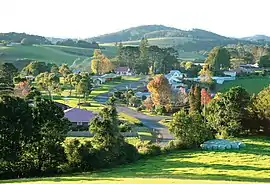Comboyne, New South Wales
Comboyne (Birrpayi: Wambuyn or Wambutj, both lit. 'kangaroo')[2] is a village on the Mid North Coast region of New South Wales. It is situated on the Comboyne Plateau, some 60 km south-west of Port Macquarie, 35 km west of Kew and 54 km north-west of Taree. It is an attractive agricultural area with fertile soils and a high rainfall. The word "Comboyne" is a corruption of the local Biripi people's name for "a place of kangaroos" (Gambuyn).[3] At the 2011 census, Comboyne had a population of 453.[1]
| Comboyne New South Wales | |||||||||
|---|---|---|---|---|---|---|---|---|---|
 Comboyne is located on the Comboyne Plateau, an area of rolling hills characterised by red basalt soils and high rainfall. | |||||||||
 Comboyne | |||||||||
| Coordinates | 31°36.352′S 152°28.101′E | ||||||||
| Population | 454 (2016 census)[1] | ||||||||
| Postcode(s) | 2429 | ||||||||
| Elevation | 705 m (2,313 ft) | ||||||||
| Location |
| ||||||||
| LGA(s) | Port Macquarie Hastings | ||||||||
| State electorate(s) | Oxley | ||||||||
| Federal division(s) | Lyne | ||||||||
| |||||||||
The Birpai (also known as Birrbay) people have lived in this area for more than 40,000 years.[4]
Previously, the area was covered in sub-tropical rainforest which has almost all been cleared by the early 20th century. The early explorers originally sought the valuable timber of the Australian Red Cedar. The second oldest natural reserve in the state is at nearby Boorganna Nature Reserve which preserves a remnant of sub-tropical rainforest. The Antarctic beech has been recorded at four sites in the Comboyne area.[5][6]
Geology and climate
The annual average rainfall at Comboyne is a high 1818 mm.[7] The climate is sub tropical, though at an elevation of 705 metres, it is cooler than at the coast nearby. Soils are derived from basalt, which provide a deep red loam. Below the basalt are less fertile sedimentary rocks. The Comboyne Shield Volcano erupted some 11 to 13 million years ago.[8] The Comboyne plateau is a scarp-bounded paleoplain located between the central north coast of New South Wales and the Great Dividing Range. Miocene basalts overlie much of the plateau, creating relatively fertile red/brown soils.[9] In the southern third of the plateau are underlying Triassic sediments of the Lorne basin.[10] The plateau has a wet, sub tropical climate,[11] though subject to frost and occasional snow.
References
- Australian Bureau of Statistics (31 October 2012). "Comboyne (State Suburb)". 2011 Census QuickStats. Retrieved 11 April 2015.
- "FirstVoices".
- National Parks and Wildlife Service pamphlet "Boorganna Nature Reserve", Department of Climate Change & Water, 2010
- "Aboriginal Community Information". Port Macquarie-Hastings Council. Retrieved 8 September 2020.
- "Lost & Found, Nothofagus moorei at Comboyne. authors C.L. Bale & J.B. Williams" (PDF). Cunninghamia. Archived from the original (PDF) on 16 March 2017. Retrieved 21 February 2017.
- Floyd, A. G. (2008). Rainforest Trees of Mainland South-eastern Australia (2nd, Revised ed.). Lismore, New South Wales: Terania Rainforest Publishing. p. 272. ISBN 978-0-958943-67-3. Retrieved 27 February 2017.
- "Peace, Quiet & Fresh Mountain Air". Comboyne. Archived from the original on 19 July 2008. Retrieved 9 August 2012.
- Seach, John. "Comboyne Volcano". Volcano Live. Retrieved 12 August 2012.
- "Red Podzolic Soil". Encyclopedia.com. Retrieved 25 March 2017.
- "Lost & Found. Nothofagus moorei at Comboyne." authors CL Bale and JB Williams" (PDF). Royal Botanic Gardens, Sydney. Cunninghamia - New South Wales. Archived from the original (PDF) on 16 March 2017. Retrieved 24 March 2017.
- "Comboyne Climate Averages". Meat & Livestock Australia. Retrieved 25 March 2017.
